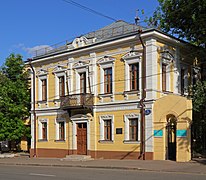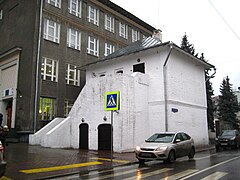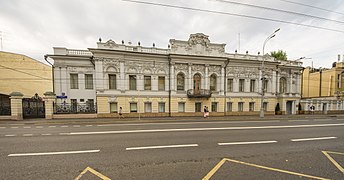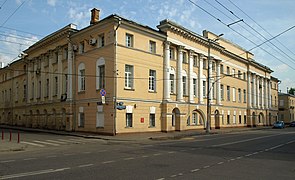Pretschistenka
The Pretschistenka , Russian Пречистенка , is a street in the district of Khamovniki in the Central Administrative District of Moscow . It leads from the square Pretschistenskije Vorota to the place Subowskaja and lies between the street Ostozhenka and Gagarinsky Alley . The length is 1.125 kilometers.
history
The road forms a cross-connection road from the Kremlin to the Novodevichy monastery ; to the west it merges into Great Pirogovskaya Street and east into what is now Volkhonka Street. Urban development along the street began in the last third of the 16th century, when what was then Chertolskaya Street belonged to Oprichnina ; the street got its current appearance at the end of the 17th century. The street got its name in honor of the Smolensk icon of Our Lady (Икона Пречистой Божьей Матери Смоленской), Prechistaya means "of the highest purity".
In the 17th century Strelizen lived in the street , most of them were killed after the suppression of the Second Strelizen Uprising or some were sent to Kiev. After that, the street gradually turned into an aristocratic residential area. Representatives of many noble families ( boyars ) lived here, for example from the houses of Vsevolschsky, Lopukhin, Eropkin and others. Now several streets near the Pretschistenka bear their names. Their wooden houses were replaced by stone buildings after the fire of 1812. In the second half of the 19th century, houses were also built for business people (Morozow, Konschin and others). Part of the building is now a listed building.
The Pretschistenka had different names over the years: from 1524 to 1658 Chertolskaya, then Pokrovskaya, Pretschistenskaya, Pretschistenka, from 1921 to 1994 Kropotkinskaya (in honor of the Russian revolutionary anarchist Pyotr Kropotkin , who was born here). On October 25, 1994, the street got its historical name Pretschistenka again.
description
In the street are among others:
- № 1/2 Prozorovssky-Palaty - stone residential building for Prince (Knas) Boris Prosorovssky. Was built from 1685 to 1688, built over in 1712–1712.
- № 11 The Lev Tolstoy Museum. The building from 1817-1822, in 1895 was rebuilt.
- № 13 / 7-1 The Rekk residential building (1910–1911, architect is Gustaw Gelrich)
- № 12 / 2-1 The Khrushchev Seleznev mansion (1814–1816), architect is A. Grigiryev. Now the Pushkin Museum is located here.
- № 12 / 2-9 Palaty from the 17th century
- № 14 The Matweewa House (overbuilt in 1875 Palaty from the 17th century).
- № 20 The Ermolow House. Was reached by Matwei Feodorovich Kazakov in the 18th century.
- № 21/12 The Morosow House. The manor house from 18th – 19th centuries Century.
- № 22 The Moscow Fire Depot (1764, the architect is likely to be Matwei Kazakow, after which it was built over. Now belongs to the Ministry of Disaster Management of the Russian Federation )
- № 28 The Isakov Residential Building (built in 1904–1906 by the architect Lev Kekushev in Art Nouveau style)
- № 32 Okhotnikov House from the 18th century, has been rebuilt several times. From 1868–1917 the famous Poliwanow-Gimnasye was located here. Here studied W. Solovyov , W. Bryusov , A. Alekhine , sons of Tolstoy , Dostoyevsky , Ostrowski, and many others.
Web links
literature
- Sergei Romanjuk. Ostoshenka, Prechistenka, Ostrov and their neighborhoods publishing house "Центрполиграф", 2016
- Alexei Mitrofanov. Pretschistenka. Publishing house "Ключ-С", Moscow, 2008.
Individual evidence
- ^ Eva Gerberding: DuMont travel paperback travel guide Moscow. P. 199 , accessed on October 28, 2017 .
- ^ Eva Gerberding: DUMONT travel paperback Moscow. Retrieved October 27, 2017 .
- ^ Sights in Moscow: Cathedral of Christ the Savior in Moscow. Retrieved October 27, 2017 .
- ↑ Darya Evdočuk: Moscow and St. Petersburg: outings in the Russian cities. Trescher Verlag, accessed on October 27, 2017 .
- ↑ Johann von Horn: Attempt to depict the burning and looting of Moscow by the French. 1813, Retrieved October 27, 2017 .
- ↑ Erhard Gorys: Moscow and St. Petersburg: Art, culture and history of the two metropolises, the "Golden Ring" and Novgorod. DuMont, accessed October 27, 2017 .











